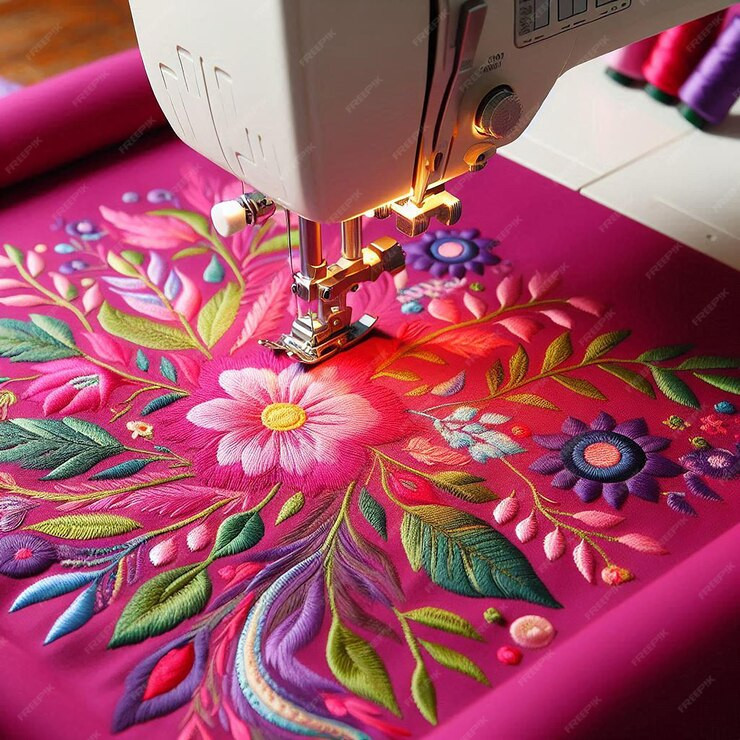Embroidery and Printing

Embroidery and Printing: Adding Personality to Your Clothing Brand
Embroidery and printing are two powerful techniques for adding unique
details to your garments. These methods help you customize your clothing
designs, making them stand out in a crowded market. Whether you’re using
embroidery to create elegant, textured patterns or printing to showcase bold
graphics, these embellishments can significantly enhance the appeal of your
clothing brand.
The Role of Embroidery in Fashion
Embroidery is the art of stitching designs, logos, or patterns onto fabric
using needle and thread. This age-old technique brings a tactile, luxurious
quality to garments, offering a level of craftsmanship that speaks to both
durability and elegance.
Types of Embroidery
1. Direct
Embroidery: The most common method, where designs are stitched
directly onto the fabric. This is ideal for logos, monograms, and decorative
designs.
2. Appliqué
Embroidery: Involves stitching a separate piece of fabric onto the
garment to create a layered look, adding texture and dimension.
3. 3D
Puff Embroidery: Uses foam beneath the stitches to create a raised,
three-dimensional effect. Often used for caps and outerwear, this adds depth
and visual interest.
4. Sequin
and Bead Embroidery: Adds sparkle and texture to garments, often used
in high-end or evening wear for a more luxurious feel.
Benefits of Embroidery
- Durability: Embroidery
lasts longer than most types of printing. The stitches hold up well
through multiple washes, maintaining their color and texture over time.
- Premium Look: The raised,
textured feel of embroidery adds a sense of luxury and craftsmanship,
making it a popular choice for high-end fashion brands.
- Customization: Embroidery
allows for intricate details and personalized touches like initials or
custom logos, making each garment unique.
How Embroidery is Done
1. Design
Creation: The embroidery process starts with a digital design. Specialized
software converts the design into a format that can be interpreted by
embroidery machines.
2. Hooping
the Fabric: The fabric is placed in a hoop to keep it taut, ensuring
even stitching.
3. Machine
Embroidery: High-speed embroidery machines stitch the design onto the
fabric. The design can include different types of stitches, colors, and
textures for a detailed finish.
4. Finishing
Touches: Once the embroidery is complete, any excess threads are
trimmed, and the garment is inspected for quality.
The Role of Printing in Fashion
Printing offers endless possibilities for creativity, allowing you to apply
bold graphics, patterns, and vibrant colors to your garments. It’s a versatile
method that can be used on a variety of fabrics and is suitable for both small
and large-scale production.
Types of Printing
1. Screen
Printing: One of the most common methods, screen printing involves
pushing ink through a stencil or screen onto the fabric. It’s ideal for bold,
single-color designs but can also be used for multi-color prints with separate
screens for each color.
2. Direct-to-Garment
(DTG) Printing: This method prints the design directly onto the fabric
using a specialized inkjet printer. It’s perfect for highly detailed designs
and small production runs, as it doesn’t require setting up screens or
stencils.
3. Heat
Transfer Printing: Involves printing a design onto transfer paper and
then applying heat to transfer it onto the fabric. This method is
cost-effective for producing small batches of custom designs.
4. Sublimation
Printing: Suitable for polyester fabrics, sublimation printing uses
heat to transfer dye directly into the fabric fibers. It’s great for all-over
prints and designs that require a high level of detail and color accuracy.
Benefits of Printing
- Vibrant Colors: Printing
allows for bold, vibrant colors that can make your designs stand out. It’s
particularly effective for graphic tees, activewear, and fashion-forward
pieces.
- Cost-Effective for Large Runs:
For large-scale production, screen printing and heat transfer printing
offer an economical solution, making it affordable to produce in bulk.
- Quick Turnaround: Printing
methods, especially DTG and heat transfer, offer fast production times,
making it ideal for on-demand or small-batch orders.
How Printing is Done
1. Design
Preparation: The design is first created digitally, ensuring that it’s
print-ready. For screen printing, separate screens are created for each color,
while DTG and heat transfer methods use a single digital file.
2. Fabric
Preparation: The fabric must be clean and smooth for the ink to adhere
properly. In screen printing, the fabric is laid flat and secured in place.
3. Printing
the Design: Depending on the method, ink or dye is applied to the
fabric through screens, printers, or heat presses.
4. Curing:
After printing, the ink needs to be cured or set, usually through heat, to
ensure it adheres properly and lasts through washes.
Choosing Between Embroidery and Printing
Choosing between embroidery and printing depends on several factors:
- Design Complexity:
Embroidery is best for small, intricate designs like logos or monograms,
while printing is better for large, detailed graphics and patterns.
- Fabric Type: Heavier
fabrics like jackets, hoodies, and hats work well with embroidery, while
lighter fabrics like t-shirts and activewear are ideal for printing.
- Cost and Quantity:
Embroidery can be more expensive, especially for large, detailed designs,
but it adds a premium feel. Printing is more cost-effective for large
quantities or complex graphics.
Combining Embroidery and Printing
Some brands choose to combine embroidery and printing on the same garment
for a truly unique look. For example, you can use printing for bold, graphic
elements and embroidery for small, textured details like logos or initials.
This combination creates depth and visual interest, offering a
multi-dimensional appeal to your garments.
Conclusion
Both embroidery and printing provide creative ways to enhance your clothing
brand’s designs. Embroidery offers a timeless, premium feel with its textured
and durable finish, while printing allows for vibrant, bold designs with
endless customization options. Choosing the right method depends on your design
needs, budget, and production scale, but both techniques can help you create
standout pieces that resonate with your customers.
Ready to add unique details to your clothing line? Explore
embroidery and printing options to elevate your designs!